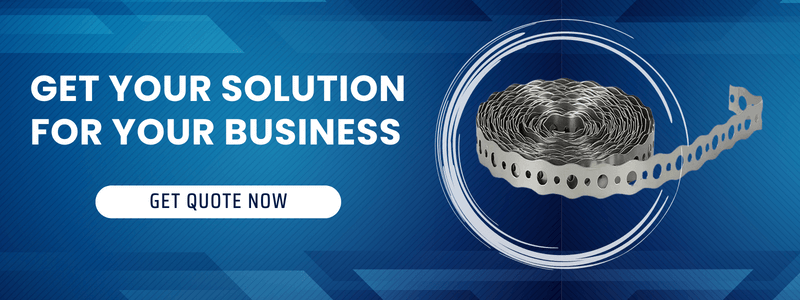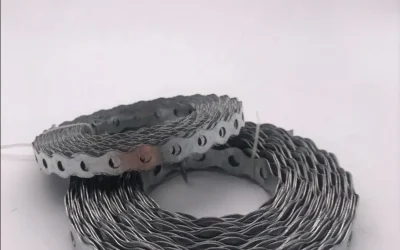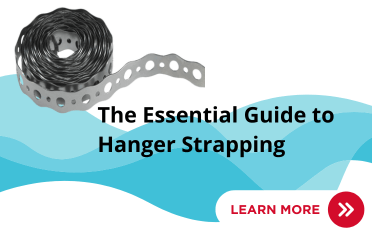Perforated hanger straps are an invaluable tool for creating secure mounts and supports in various residential, commercial and industrial applications. These metal straps feature holes throughout their length, allowing for adjustable positioning and installation. In this comprehensive guide, we’ll explore everything you need to know about perforated hanger straps, from their key features and benefits to proper selection and safe installation techniques. Read on to learn how these versatile products can meet the demanding support needs of any project.
Introduction to Perforated Hanger Straps
Perforated hanger straps, also known as punched strap hangers or panel straps, are strips of high-strength metal designed to hang or support piping, ductwork, conduit, cables, and other components. Holes are punched along the length of the strap at regular intervals, enabling adjustability for suspending items at any point across the strap’s span.
Hanger straps provide a reliable, cost-effective alternative to fabricated supports or welded attachments. Their simple design offers flexibility not found in custom brackets or hangers. Made from durable galvanized steel or stainless steel, perforated straps stand up to years of heavy use across diverse environments.
Whether supporting pipes in an industrial facility, or shelving in a home closet, perforated hanger straps deliver the adaptable strength needed for secure installation. Keep reading to learn more about how these ubiquitous products can tackle any mounting challenge.
Understanding Perforated Hanger Straps

Perforated hanger straps consist of a flat strip of metal, anywhere from 1/2” to 4” wide in standard sizes. Lengths range from a couple feet up to 20 feet for long span coverage. The metal itself is galvanized or stainless steel around 16 to 12 gauge thick for rigidity and strength.
The key feature that makes these products so versatile is the series of uniformly spaced holes punched along the strap’s length. Hole spacing standards are every 1”, 2”, or 4” depending on the strap. This adjustability allows hanging at any point across a span.
Other helpful design elements include beveled edges to prevent injury, reinforced eyelet holes for sling applications, and a radiused strap profile to increase strength. Premium straps may also have crimped holes to grip threaded rods or bolts.
Benefits of Perforations
The perforated hole design offers great advantages:
- Adjustability – Variable positioning for optimal placement of hung items
- Versatility – Suitability for diverse hanging and securing needs
- Strength – Holes don’t compromise integrity of the strap
- Ventilation – Airflow between holes for certain applications
- Aesthetics – Visually appealing industrial look
In short, the perforations deliver enhanced utility without reducing the fundamental performance of the metal strap itself.
Applications of Perforated Hanger Straps
Let’s explore some of the most common ways perforated hanger straps are utilized across industries:
Construction & Building
Perforated hanger straps are ubiquitous on construction sites and in commercial buildings. Their adjustability allows securing structures at any point, while strength supports heavy ducts and pipes. Common uses include:
- Suspending HVAC ductwork, pipes, and vents
- Managing electrical conduits and bus bars
- Mounting water and gas piping runs
- Securing temporary scaffolding and shoring
Contractors rely on perforated straps for creating orderly, rigid installations able to withstand vibration and load stresses over decades.
Plumbing
Securing plumbing components in commercial, industrial, and residential settings is another prime application for perforated hanger straps. Usages include:
- Mounting pipes vertically or horizontally
- Attaching fixtures like sinks or toilets to framing
- Anchoring pipe runs to joists and studs
- Creating clean customizable layouts
The flexibility of attachment points and range of weight capacities accommodate any plumbing need.
Electrical
Electricians employ perforated hanger straps for safely managing electrical systems, such as:
- Suspending wire conduits through buildings
- Running feeder cables along beams
- Mounting junction boxes on framing
- Organizing plenum cabling trays and raceways
Adjustability ensures secure positioning while strength prevents conduit strains.
DIY & Storage
Around the house, perforated straps have many uses, including:
- Building customized shelving and storage solutions
- Hanging closet rods, buckets, and baskets
- Mounting workshop jigs and tools
- Securing recreational gear in garages
DIYers appreciate the simplicity of creating exactly what’s needed.
Advantages of Perforated Hanger Straps
Now that we’ve surveyed the wide range of applications, let’s drill down on the unique benefits afforded by the perforated hanger strap design:
Structural Stability
The combination of durable metal construction and adjustable hanging points provides rock-solid stability for suspended items. Mounting is secure along the entire length of a run. Perforations also allow for hanger clips to restrain movement in multiple directions.
Flexible Arrangements
The variability of attachment points permits hanging items precisely where needed. Plumbing and conduits can be neatly organized by mounting in parallel rows or at required intervals. Irregular joist spacing can be accommodated.
Corrosion Resistance
Stainless steel straps withstand wet conditions, salt air, chemicals, UV rays and more. Galvanized coatings prevent rust for long service life. Proper materials mean hanger systems maintain integrity over decades.
Lightweight Strength
Despite minimal weight, these straps offer impressive load capacity. Many exceed several hundred pounds support, with heavy duty versions rated up to 16,000 lbs! Suitable for pipes, motors, HVAC — just about anything.
Cost-Effective Solution
Perforated straps are very economical compared to custom fabricated hangers. Their versatility also saves money by avoiding special one-off brackets. One strap solves many problems!
Choosing the Right Perforated Hanger Strap
With so many variations available, it’s important to select the right perforated hanger strap for your specific needs:
- Material – Galvanized or stainless steel offer corrosion resistance. Certain alloys maximize strength.
- Gauge/Thickness – Heavier strips support greater loads but still allow forming.
- Width – Wider straps provide a stronger base for heavy items.
- Hole Spacing – More hole density allows precision positioning of hung components.
- Hardware – Consider needs for clips, hooks, bolts and other attachments.
Also factor in length required, slotted vs. non-slotted holes, and any special environmental considerations. Experienced vendors can recommend ideal products based on your exact application specifications and requirements.
Perforated Strap Installation Techniques
Proper installation is critical to leverage the benefits of perforated hanger straps and ensure dependable performance. Follow these best practices:
Safety First
Use caution when working at height or lifting heavy components. Wear protective eyewear, gloves, helmets as warranted. Inspect all equipment prior to use.
Clean Surfaces
Remove any dirt, dust or oil so straps seat tightly against mounting surfaces. Debris compromise grip.
Mind the Spacing
Space straps according to manufacturer guidance, based on weight loads. Typical spacing is 5’-6’ for pipe runs.
Use Proper Fasteners
Follow specs for fastener type, size, and torque settings. Do not substitute hardware.
Attach Snugly
Bend straps to fit surface contours. Tighten bolts so strap fits flush without warping or buckling.
Confirm Load Capacity
Verify weight of hung components is within rated capacity of straps and hardware. Overloading risks failure.
Following these best practices results in hanger systems that will securely support assets and withstand abuse over many years of service.
Step-by-Step Installation Guide
Let’s look at the complete process for proper perforated hanger strap installation:
- Gather materials – strap, fasteners, tools. Use hardware suited for the mounting surface.
- Measure overall span to determine required strap length. Allow extra for trimming.
- Determine desired height for hung item. Mark location on mounting surface.
- Affix one end of the strap to the surface using properly sized fasteners.
- Raise hung item into position and mark strap hole closest to the support point.
- Remove strap and trim to needed length using a hacksaw or cutoff wheel.
- Return strap to marked hole. Use fasteners to attach both ends to mounting surface.
- Verify strap is fully secured and trim components don’t exceed load ratings.
Follow manufacturer instructions for any special fastening considerations or hardware.
Safety Measures for Installation
While perforated hanger straps simplify supporting components, proper precautions are still needed for safe and successful installation:
- Use assistance or lifting aids when raising heavy objects into position. Proper lifting technique prevents back
- Wear protective gloves when handling straps to avoid cuts from sharp edges. Use sturdy work gloves.
- Use caution when operating power tools like saws or drills to trim or install straps. Follow all tool safety guidelines.
- Wear eye protection when cutting straps or drilling mounting holes to prevent flying debris.
- Use appropriate ladders or lifts when mounting straps at height. Ensure stable positioning and follow heights safety.
- Select straps rated for adequate load capacity with a safety margin. Overloading can lead to failure.
- Use care when bending or forming straps to avoid kinking or distorting the metal. This weakens the strap.
- Ensure mounting points are solid. Brick, concrete, or studs are ideal. Drywall alone is insufficient.
- Double check all fasteners are tightened to their specified torque setting for maximum holding power.
- Periodically inspect installed straps for any signs of corrosion, bending, cracking or loose fasteners.
- Replace damaged straps immediately to prevent failure. Check weight ratings are still adequate.
- Organize plumbing, cables, and conduits to prevent dense bundling. Evenly distribute load.
Following safe installation and maintenance practices ensures perforated hanger straps continue securely supporting systems long into the future.
Case Studies: Real-Life Applications
HVAC Support in Office Building
A new 12 story office needed perforated hanger straps to support ductwork throughout. Stainless steel straps prevented corrosion while flexibility simplified navigating tight spaces. Engineers suspended ducts of up to 500 lbs safely and meticulously organized all runs.
Plumbing Reno in Hotel
Updating bathrooms and kitchens in an aging hotel was a massive project. Plumbers used perforated straps to rearrange and optimize pipe layouts. Adjustability allowed fast remodeling without new welding or fabrication. Strong galvanized steel has performed reliably for over a decade.
Securing Solar Array
A rooftop solar array needed securing on a flat industrial roof. Perforated metal straps provided lightweight strength to anchor the photovoltaic frames without penetrating the fragile roof membrane. The simple, low-profile straps blended aesthetically while protecting a valuable investment.
Expert Tips and Best Practices
- When supporting multiple pipes, alternate strap rows to distribute load evenly across framing.
- Pad sharp strap edges with rubber grommets when securing wiring or delicate materials.
- For heavy ductwork, use wider straps and sandwich the mounting surface between overlapping straps.
- Periodically check for wear at stress points – this can indicate overloading.
- Stagger conduits/cables across width of strap to prevent dense bundling.
Innovations and Future Trends
- Stronger alloys and tempering increase weight ratings for extreme loads.
- Curved and custom shaped straps simplify mounting around complex contours.
- Interactive calculators determine required strap specs based on project data.
- Perforations may become sites for integrated sensors or smart technology.
- Expanded use securing solar panels, turbines, and sustainable technologies.
Conclusion
Perforated hanger straps are clearly an indispensable tool for both commercial and residential applications. Their unrivaled adjustability, strength, and simplicity empower creative solutions while ensuring secure support. This guide has hopefully illuminated the immense versatility of perforated straps. We encourage you to explore ways they could enhance your next installation challenge!
Unleashing the Versatility: 28 Gauge Galvanized Banding Iron
Introduction In the ever-evolving world of construction and industrial applications, the demand for robust and reliable materials is paramount. Among the myriad of options available, the 28 gauge galvanized banding iron stands out as a versatile and indispensable...
Ultimate Guide to Heavy-Duty Metal Hanger Straps for Construction
Introduction In the world of construction, where structural integrity and safety are paramount, heavy-duty metal hanger straps play a crucial role. These unsung heroes are the backbone of many building projects, providing essential support and ensuring that critical...
The Strength and Versatility of Perforated Metal Hanger Straps
In factories, commercial buildings, and infrastructure projects everywhere, perforated metal hanger straps provide a simple and effective way to securely mount pipes, tubes, ducts, cables, and more. These adjustable metal straps can be cut to length and bent to fit a...

Justin Wong
Hi, I’m Justin, the technical engineer of Jiangmen Masters. We’ve been running a factory in China that makes metal hanger strap for 16 years now, and the purpose of this article is to share the knowledge related to metal hanger strap from a Chinese supplier’s perspective.




